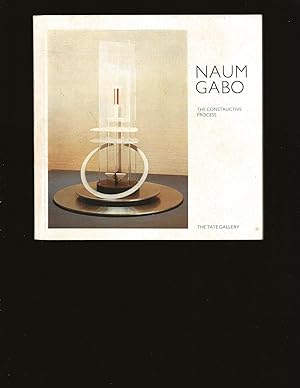Naum Gabo Foreword Sir Norman (1 results)
Product Type
- All Product Types
- Books (1)
- Magazines & Periodicals
- Comics
- Sheet Music
- Art, Prints & Posters
- Photographs
- Maps
- Manuscripts & Paper Collectibles
Condition
Binding
- All Bindings
- Hardcover
- Softcover (1)
Collectible Attributes
Free Shipping
Seller Location
Seller Rating
-
Naum Gabo (Only Signed Book)
Published by The Tate Gallery, Millbank, London, 1976
ISBN 10: 0905005651ISBN 13: 9780905005652
Seller: Rareeclectic, Pound ridge, NY, U.S.A.
Book First Edition Signed
Soft cover. Condition: Very Good. Naum Gabo; Photography by Michael Duffett and David Nye (illustrator). 1st Edition. File this under 'Ouch, do I really want to sell this?'. Apparent first edition (NAP). Once listed, this will be the Only signed copy of this book for sale anywhere on the Internet. To find the artist's signature on any book is rare indeed. The signed inscription is to the former New York Times art critic John Russell. Mr. Russell wrote Mr. Gabo's obituary for the New York Times in 1977. This 63 page book was published by The Tate Gallery for the exhibition of 3 November--12 December 1976. There is a frontispiece photograph of the artist (and his dog) posing in front of one of his huge sculptures. The Foreword, which runs from page 9 to 20 is written by Sir Norman Reid. That is followed by an essay (pages 21-26) titled The Realistic Manifesto, 1920 written by Gabo and his brother, the sculptor Antoine Pevsner. There are 23 pages of photographs of his works followed by Biographical Notes & Principal Exhibitions (51-55). A seven-page Catalogue provides a short description of the works in the exhibition. The book concludes with a short Bibliography. The book is in very nice condition. You can see the covers in the photos. There's just a bit of light toning. There is one very tiny spot at the front bottom corner. There aren't any tears. The page edges are quite clean. The spine is not slanted. The book is very solidly bound from cover to cover with nicely tight pages throughout and nicely tight covers as well. The glossy pages are in excellent condition. They are very clean. There isn't any foxing. I'm not seeing any soiling anywhere in the text. There are two speck-sized spots on the blank side of the Bibliography page. The pages are not toned. There are no markings. No attachments. And with the exception of the artist's signed inscription, no one has written their name or anything else anywhere in the book. 'Naum Gabo, born Naum Neemia Pevsner (1890-1977), was an influential sculptor, theorist, and key figure in Russia's post-Revolution avant-garde and the subsequent development of 20th century sculpture. His work combined geometric abstraction with a dynamic organization of form in small reliefs and constructions, monumental public sculpture and pioneering kinetic works that assimilated new materials such as nylon, wire, lucite and semi-transparent materials, glass and metal. Responding to the scientific and political revolutions of his age, Gabo led an eventful and peripatetic life, moving to Berlin, Paris, Oslo, Moscow, London, and finally the United States, and within the circles of the major avant-garde movements of the day, including Cubism, Futurism, Constructivism, the Bauhaus, de Stijl and the Abstraction-Création group. Two preoccupations, unique to Gabo, were his interest in representing negative space--"released from any closed volume" or mass--and time. He famously explored the former idea in his Linear Construction works--used nylon filament to create voids or interior spaces as "concrete" as the elements of solid mass--and the latter in his pioneering work, Sculpture (Standing Waves), often considered the first kinetic work of art.' 'John Russell was a British American art critic. He was an unpaid intern at the Tate Gallery in 1940, but moved to the country after the gallery was bombed. During World War II he worked in Naval Intelligence for the Admiralty. There he met Ian Fleming, who helped him to secure a reviewing position at The Sunday Times. Art critic Hilton Kramer of The New York Times hired Russell in 1974. Russell was chief art critic there from 1982 to 1990. Gabo died less than a year after the Tate exhibition. Shortly after the exhibition, Russell wrote, 'he presented the Tate with a substantial number of his sculptures, models for sculptures, and drawings. It was a matter of particular pride with him that in 1971 he received an honorary knighthood from Queen Elizabeth II in recognition not only of his life's work, but of his close association with Britain.'. Inscribed by Author(s).


